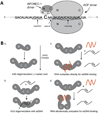Functions and regulation of the APOBEC family of proteins
- PMID: 22001110
- PMCID: PMC4017262
- DOI: 10.1016/j.semcdb.2011.10.004
Functions and regulation of the APOBEC family of proteins
Abstract
APOBEC1 is a cytidine deaminase that edits messenger RNAs and was the first enzyme in the APOBEC family to be functionally characterized. Under appropriate conditions APOBEC1 also deaminates deoxycytidine in single-stranded DNA (ssDNA). The other ten members of the APOBEC family have not been fully characterized however several have deoxycytidine deaminase activity on ssDNAs. Despite the nucleic acid substrate preferences of different APOBEC proteins, a common feature appears to be their intrinsic ability to bind to RNA as well as to ssDNA. RNA binding to APOBEC proteins together with protein-protein interactions, post-translation modifications and subcellular localization serve as biological modulators controlling the DNA mutagenic activity of these potentially genotoxic proteins.
Copyright © 2011 Elsevier Ltd. All rights reserved.
Figures



References
-
- Smith HC. The APOBEC1 Paradigm for Mammalian Cytidine Deaminases that Edit DNA and RNA. In: Grosjean H, editor. Austin. Chapter 15. Landes BioScience; 2009. pp. 181–202.
-
- Powell LM, Wallis SC, Pease RJ, Edwards YH, Knott TJ, Scott J. A novel form of tissue-specific RNA processing produces apolipoprotein- B48 in intestine. Cell. 1987;50:831–840. - PubMed
-
- Chen SH, Habib G, Yang CY, Gu ZW, Lee BR, Weng SA, et al. Apolipoprotein B-48 is the product of a messenger RNA with an organ- specific in-frame stop codon. Science. 1987;238:363–366. - PubMed
-
- Teng B, Burant CF, Davidson NO. Molecular cloning of an apolipoprotein B messenger RNA editing protein. Science. 1993;260:1816–1819. - PubMed
Publication types
MeSH terms
Substances
Grants and funding
- AI58789/AI/NIAID NIH HHS/United States
- R01 GM110568/GM/NIGMS NIH HHS/United States
- DK43739/DK/NIDDK NIH HHS/United States
- R01 GM110119/GM/NIGMS NIH HHS/United States
- R01 DK043739/DK/NIDDK NIH HHS/United States
- GM068411/GM/NIGMS NIH HHS/United States
- AI54369/AI/NIAID NIH HHS/United States
- R21 NS067671/NS/NINDS NIH HHS/United States
- T32 GM068411/GM/NIGMS NIH HHS/United States
- R21 AI054369/AI/NIAID NIH HHS/United States
- P30 078498/PHS HHS/United States
- AI095007/AI/NIAID NIH HHS/United States
- R21 AI076085/AI/NIAID NIH HHS/United States
- R21 AI058789/AI/NIAID NIH HHS/United States
- AI076085/AI/NIAID NIH HHS/United States
- R21 AI095007/AI/NIAID NIH HHS/United States
- NS067671/NS/NINDS NIH HHS/United States
- R33 AI076085/AI/NIAID NIH HHS/United States
LinkOut - more resources
Full Text Sources
Other Literature Sources
Molecular Biology Databases

